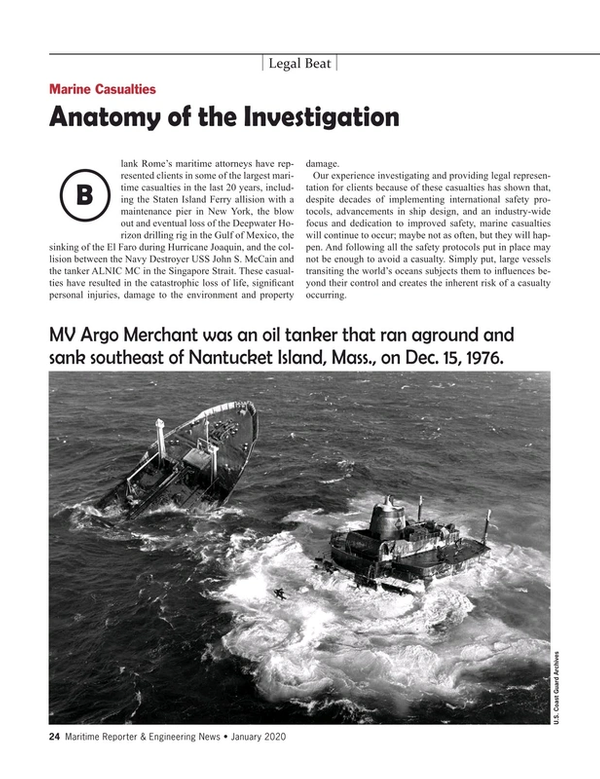
Anatomy of a Marine Casualty Investigation
Blank Rome’s maritime attorneys have represented clients in some of the largest maritime casualties in the last 20 years, including the Staten Island Ferry allision with a maintenance pier in New York, the blow out and eventual loss of the Deepwater Horizon drilling rig in the Gulf of Mexico, the sinking of the El Faro during Hurricane Joaquin, and the collision between the Navy Destroyer USS John S. McCain and the tanker ALNIC MC in the Singapore Strait. These casualties have resulted in the catastrophic loss of life, significant personal injuries, damage to the environment and property damage.
Our experience investigating and providing legal representation for clients because of these casualties has shown that, despite decades of implementing international safety protocols, advancements in ship design, and an industry-wide focus and dedication to improved safety, marine casualties will continue to occur; maybe not as often, but they will happen. And following all the safety protocols put in place may not be enough to avoid a casualty. Simply put, large vessels transiting the world’s oceans subjects them to influences beyond their control and creates the inherent risk of a casualty occurring.
Obviously, the shipping industry’s primary goal should always be to have zero lost days due to accidents. But, equally, the industry should also always be prepared to immediately respond to and investigate unfortunate events when they occur. In this regard, it is critical to understand the investigative process that occurs when a significant marine casualty occurs.
First, it is important to note that although not required, it is not unusual for the National Transportation Safety Board (NTSB) and the United States Coast Guard (USCG) to coordinate, in part, their efforts to investigate and establish the root cause of a marine casualty. The process by which the NTSB and USCG investigate a casualty are similar in many ways, but different in some key areas. And recommendations made by the NTSB and/or the USCG, if any, following the conclusion of their respective investigations, differ in scope.
If you are an owner, operator or an entity with a role in the events that led to the casualty, you may be designated a party-in-interest following a marine casualty. An example of an entity that is not an owner or operator who may be designated a party-in-interest could include a port pilot or an equipment manufacturer. Whatever your role may be, it is important to understand the purpose and eventual outcome of both the NTSB’s and USCG’s investigations.
The NTSB
The NTSB’s stated purpose can be found on their website:
"The National Transportation Safety Board is an independent Federal agency charged by Congress with investigating every civil aviation accident in the United States and significant accidents in other modes of transportation – railroad, highway, marine and pipeline.”
Although the principal purpose of the NTSB is to investigate aviation accidents, it is also tasked with investigating significant marine accidents. The NTSB has five Board Members, each nominated by the President and confirmed by the Senate to serve five-year terms. A Member is designated by the President as Chairman and another as Vice Chairman for two-year terms. Notably, none of the current or recent Board Members have worked in the marine industry. However, the NTSB does have a designated marine department made up of numerous professional with significant marine experience. They include licensed Masters, Chief Engineers, Naval Architects, and other experts in various marine related fields of study.
Following notice of a major marine casualty, the NTSB’s investigation team – called the “Go Team” – begins its investigation. Depending on the severity and or technical challenges relating to the marine casualty, the “Go Team” can be a small unit or a large unit comprised of personnel with a broad spectrum of technical expertise that is needed to solve complex transportation safety issues. The “Go Team” can also be comprised of three to four dozen specialists from the NTSB’s headquarters in Washington, D.C. Team members are assigned on a rotational basis to respond as quickly as possible to the scene of the accident. The fact-finding mission of the investigation begins at the accident scene. The NTSB will inspect all vessels and equipment involved in the incident.
The NTSB may designate parties-in-interest following a marine casualty. The upside to the designation is it provides the party-in-interest access to information not provided to the public or others involved in the incident. The downside, however, is the NTSB may restrict a party-in-interest from independently investigating the incident, including interviewing employees and witnesses.
The NTSB’s investigation will likely include a robust review of the Safety Management System and the safety culture of all entities involved in the casualty. The NTSB may serve comprehensive document requests and interview crew members and employees of companies involved in the incident. A corporate representative is permitted to attend crew and employee interviews, but witnesses are not entitled to have a lawyer present. With the consent of the NTSB, a company’s general counsel may attend the interview.
Following the completion of its investigation, the NTSB will issue a preliminary report. The NTSB will request input from the parties-in-interest and are receptive to their input because the goal of the NTSB is not to find fault but to determine the probable cause of an accident and issue safety recommendations aimed at preventing future accidents. In our experience, the NTSB has accepted changes to its preliminary report when the recommendations are based on credible facts and well-founded expert opinion. Thus, it is vital to have respected experts available to review the NTSB’s preliminary report.
Once the investigation is complete and the NTSB reviews the input from the parties-in-interest, the NTSB will issue its final report. It is important to note that in the final report, which is made public on their website, the NTSB will not specifically attribute fault to any individual or entity. Nor will the NTSB recommend a penalty, punishment or sanction. The NTSB report, which is not admissible in a United States court proceeding, will provide only a factual background and state what the NTSB thinks is the probable cause of the incident. That said, the findings of the NTSB will obviously give a roadmap for other governmental agencies and/or litigants to independently build a legal case of who is at fault and why, which is why a party-in-interest’s participation in the investigation and comments on the preliminary report are critical.
Finally, following the issuance of its final report, the NTSB will generally hold a public hearing at which time the findings of the report will be announced publicly.
The USCG
As the primary agency responsible for marine safety, the USCG is tasked with investigating marine casualties. The investigations range from obtaining and analyzing evidence for minor incidents to establishing a marine board of investigation to investigate incidents involving serious personal injury, death, and significant environmental and property damage. The purpose of every USCG investigation is to analyze the facts surrounding the casualty, determine the cause(s) of the casualty, and, if necessary, initiate corrective actions.
Significant investigations are spearheaded by a USCG Lead Investigating Officer who will have substantial experience investigating marine casualties. He will be supported by USCG and civilian casualty investigators, technical experts, legal advisors, and other support personnel from within the USCG. Significant investigations also often include cooperation between the USCG and NTSB, which increases the compliment of skills investigating the casualty. The NTSB and USCG will, however, issue separate reports.
The primary mission of the USCG when investigating marine casualties is to determine the root cause(s) and to use the information gathered during the investigative process to consider promulgating new rules or advisories to prevent further casualties. Additionally, the USCG, unlike the NTSB, will determine if there were acts of negligence, misconduct or other violations of federal law that caused the casualty. And, if so, the USCG may refer the matter to the United States Department of Justice for a further review to determine whether a crime was committed.
Like the NTSB, if a major marine casualty occurs, the USCG also will designate parties-in-interest, who are typically individuals or entities that have a direct interest in the outcome of the investigation. In a joint investigation, the USCG and NTSB will agree on who to designate as a party-in-interest. Unlike a NTSB investigation, a party-in-interest may be represented by counsel at all stages of a USCG investigation, including when giving testimony. From the USCG’s perspective, the primary role of a party-in-interest is to help the USCG gather the facts which led to the casualty. The USCG will request documents, access to computers and testimony from witnesses. If an entity or witness is not voluntarily cooperating, the USCG has the authority to issue administrative subpoenas to require the production of documents and information and to summon witnesses for testimony. Testimony at a formal hearing is usually open to the public unless it involves classified materials or affects national security.
After gathering the relevant documents and witness testimony, the USCG will analyze all of the evidence to determine, as best as possible, the cause of the accident. At the completion of the investigation, a Report of Investigation will be prepared by the Lead Investigating Officer and his or her team. The report will contain findings of fact, causal analysis, conclusions, and safety recommendations. Unlike in the NTSB investigation, a party-in-interest is not typically given an opportunity to comment on the USCG’s report until after it is finalized and submitted to the Commandant of the USCG for review and approval. The final report will be released to the public once approved by the Commandant.
In sum, while the NTSB and USCG strive for the same goal of determining the cause(s) of a marine casualty in order to identify safety recommendations that will hopefully prevent similar events in the future, the NTSB and USCG’s investigative process and the scope and ultimate results of their reports differ. Thus, it is important for a party-in-interest to understand the differences between the two, so it can safely navigate the investigative process should it ever find itself in the unfortunate position of participating in one.
About the Authors

William Bennett is a Partner in Blank Rome LLP’s New York office. He is Co-Practice Group Leader of the Maritime and International Trade Group and a graduate of SUNY Maritime. Prior to his legal career, he sailed as a licensed officer aboard various types of vessels. His practice focuses on serving clients in the global shipping, energy and international trade markets. He counsels owners, operators, managers, charterers, commodity traders, marine terminals and logistics companies.

Lauren Wilgus is Of Counsel in Blank Rome LLP’s New York office. Wilgus concentrates her practice in the areas of international and maritime litigation and dispute resolution. Her practice focuses on serving clients in all sectors of the global shipping, energy and international trade markets. Prior to joining the firm, Lauren worked both as a claims adjuster at a major Japanese shipping company and as a claims executive at the UK P&I Club.
Read Anatomy of a Marine Casualty Investigation in Pdf, Flash or Html5 edition of January 2020 Maritime Reporter
Other stories from January 2020 issue
Content
- Training Tips for Ship: #8 - The Lecture is Dead page: 10
- Offshore Wind: The Domino Effect page: 14
- IMO2020: Low Sulfur Fuel Potential Pitfalls page: 16
- Want to Cut Emissions? SLOW DOWN page: 18
- Anatomy of a Marine Casualty Investigation page: 24
- Anatomy of a Marine Casualty Investigation page: 24
- Ship Repair: How to Foil Well-laid Plans page: 28
- Are OSVs Fit for Refit for Offshore Wind? page: 32
- @ Glosten: “Crazy ideas are not off the table” page: 36
- Ship Repair: Bayonne Drydock Invests in Shiplift page: 42


